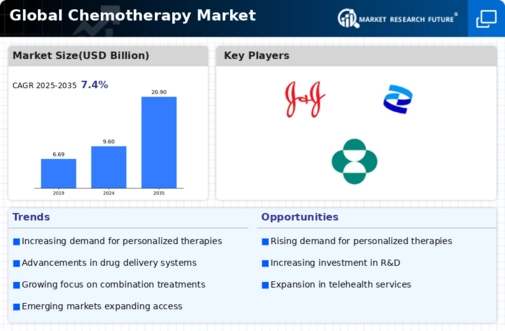Market Share
Chemotherapy Market Share Analysis
The global chemotherapy market is divided based on the type of drugs used, including alkylating agents, antimetabolites, mitotic inhibitors, antitumor antibiotics, topoisomerase inhibitors, and others.
Alkylating agents, the first anti-cancer drugs developed, accounted for USD 10,443.96 million in 2018 and are expected to grow at a rate of 11.83% during the forecast period. These agents directly impact DNA, leading to cross-linking of DNA strands, abnormal base pairing, or DNA strand breaks, preventing cell division. However, they are less effective in rapidly growing cells.
Mitotic inhibitors make up the second-largest segment and are anticipated to grow at a rate of 11.64% during the forecast period.
In terms of medical conditions treated, the chemotherapy market is categorized into leukemia, lymphoma, breast cancer, ovarian cancer, lung cancer, myeloma, sarcoma, and others.
The lung cancer segment, valued at USD 4,049.09 million in 2018, is expected to grow at a rate of 11.88% during the forecast period. This high market share is due to the widespread prevalence of lung cancer, with approximately 2,093,876 new cases diagnosed globally in 2018, according to the World Cancer Research Fund. Lung cancer is a leading cause of cancer-related deaths, constituting about 13% of all new cancer cases, as reported by the American Cancer Society.
Breast cancer, with a value of USD 3,687.71 million in 2018, holds the second-largest share. It is a significant concern for women globally, with 2,088,849 new cases reported in 2018, according to the National Cancer Institute. The number of new cases of female breast cancer is reported to be 127.5 per 100,000 women per year.
Other medical conditions covered in the market include oral cancer, soft tissue cancer, genital cancer, urinary system cancer, eye cancer, brain tumor, and endocrine system cancer. Each of these conditions presents unique challenges and requires specific treatment approaches.
In conclusion, the global chemotherapy market is diverse, addressing various medical conditions through different drug types. The market continues to grow, driven by the increasing prevalence of cancer and advancements in chemotherapy treatments. The focus remains on developing effective drugs for different types of cancers to improve patient outcomes and overall healthcare.
\









Leave a Comment